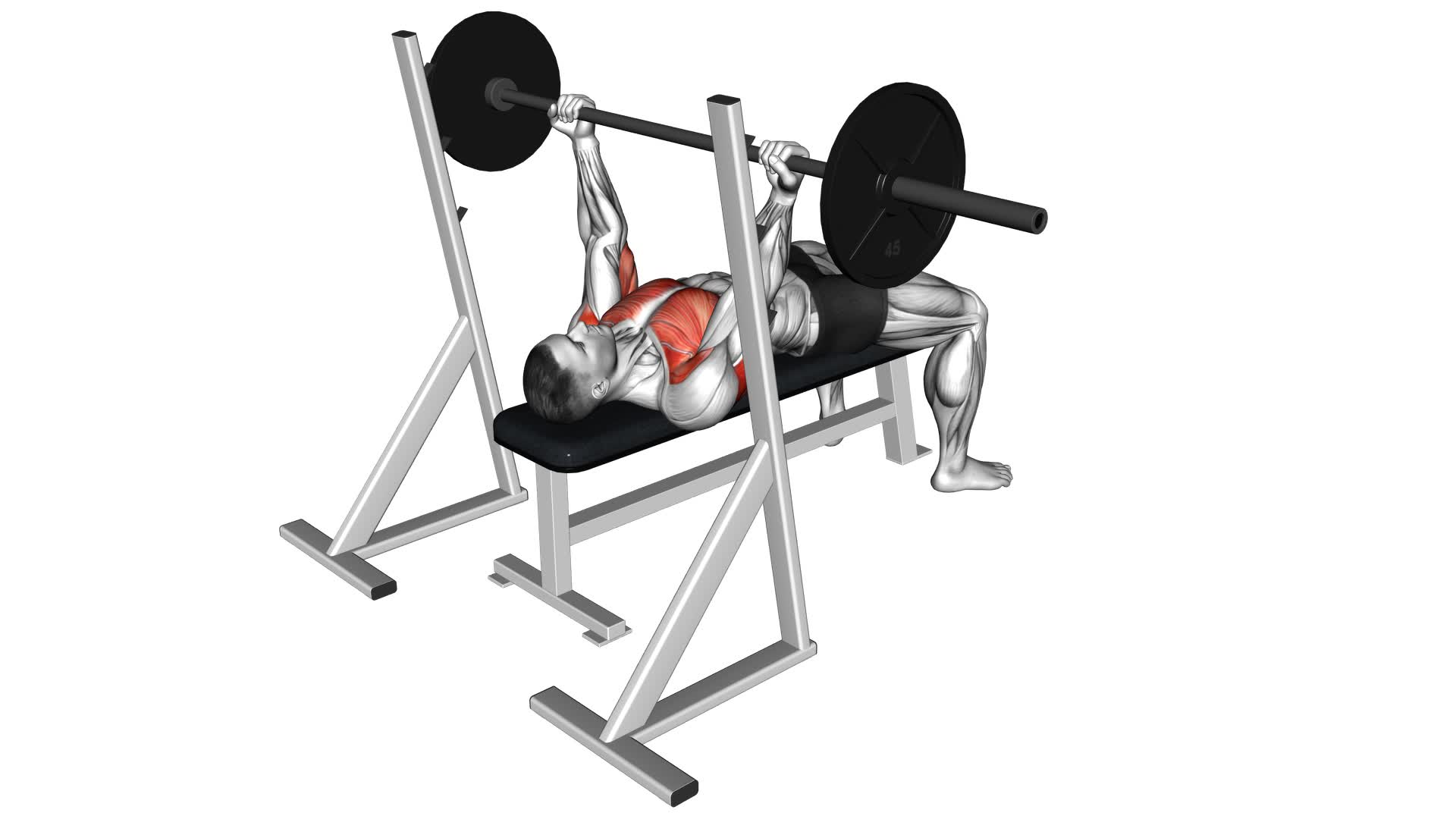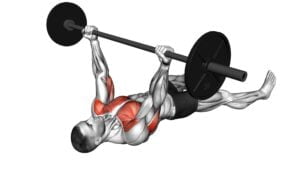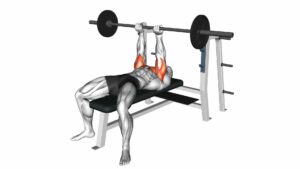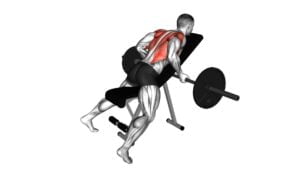Barbell Reverse Grip Bench Press – Video Exercise Guide & Tips

Are you looking for a powerful exercise to target your chest and triceps? Look no further than the barbell reverse grip bench press!
Watch This Exercise Video
In this video guide, we'll show you how to perform this exercise with proper form and technique, while providing helpful tips to avoid common mistakes.
With variations and progressions to challenge yourself, you can maximize your results and achieve a stronger upper body.
Get ready to pump up those muscles and reach new levels of strength!
Key Takeaways
- The reverse grip bench press targets the triceps and chest muscles more effectively than the traditional bench press.
- Proper form and technique are crucial for injury prevention when performing the reverse grip bench press.
- The reverse grip bench press can help alleviate shoulder stress for individuals with certain shoulder issues.
- Incorporating variations and progressions into the reverse grip bench press can maximize results and continue challenging the muscles.
Benefits of the Reverse Grip Bench Press
One benefit of the Reverse Grip Bench Press is that it targets your triceps and chest muscles more effectively than the traditional bench press. By using an underhand grip, with your palms facing towards you, you activate your triceps to a greater extent. This increased muscle activation in the triceps helps to develop strength and size in these muscles. Additionally, the reverse grip also places more emphasis on your chest muscles, particularly the lower portion. This allows for a more balanced development of the chest muscles, targeting both the upper and lower regions.
In terms of injury prevention, the Reverse Grip Bench Press can be advantageous. The underhand grip puts less stress on your wrists and shoulders compared to the traditional bench press. This reduced strain on these joints can help to minimize the risk of injuries, such as wrist or shoulder impingement. It's important to note, however, that proper form and technique are still crucial to prevent any potential injuries.
Transitioning into the subsequent section about 'proper form and technique', it's essential to understand how to perform the Reverse Grip Bench Press correctly to maximize its benefits and minimize the risk of injury.
Proper Form and Technique
To perform the Reverse Grip Bench Press with proper form and technique, follow these steps.
First, lie down on a flat bench with your feet firmly planted on the ground. Grab the barbell with an underhand grip, slightly narrower than shoulder-width apart. Make sure your palms are facing towards you.
Before unracking the barbell, retract your shoulder blades and squeeze them together. This will create a stable base for the exercise.
Unrack the barbell and slowly lower it towards your chest, keeping your elbows tucked in close to your body. Aim to touch your chest with the barbell, but avoid bouncing it off your chest. Once at the bottom, push the barbell back up explosively, fully extending your arms. Remember to keep your core engaged and your back flat throughout the movement.
Now, let's address some common misconceptions about the Reverse Grip Bench Press.
One misconception is that this exercise primarily targets the upper chest. While it does engage the upper chest muscles, it also activates the triceps, shoulders, and even the biceps to a certain extent. The reverse grip allows for a greater emphasis on the triceps, making it a valuable variation for targeting those muscles.
In terms of muscle activation, the Reverse Grip Bench Press places more emphasis on the triceps compared to the traditional bench press. This is due to the change in grip position, which alters the biomechanics of the movement. Additionally, the reverse grip can also help to alleviate shoulder stress for individuals with certain shoulder issues.
Common Mistakes to Avoid
Avoid these common mistakes when performing the Barbell Reverse Grip Bench Press.
One of the most common misconceptions about the reverse grip bench press is that you should use the same weight as you'd for a regular bench press. However, this isn't the case. Due to the change in hand position, the reverse grip bench press puts more emphasis on the triceps and shoulders, so you may need to decrease the weight to maintain proper form and prevent injury.
Another mistake to avoid is flaring your elbows out to the sides during the exercise. This can put unnecessary strain on your shoulders and increase the risk of injury. Instead, keep your elbows tucked in close to your body, forming a 45-degree angle with your torso. This will help to engage your triceps and chest muscles more effectively.
When performing the reverse grip bench press, it's important to maintain a stable and neutral spine. Avoid arching your back excessively or allowing it to round during the exercise. This can put undue stress on your lower back and increase the risk of injury. Keep your core engaged and your back in a natural, neutral position throughout the movement.
To prevent injury during the reverse grip bench press, it's crucial to warm up properly and use proper form and technique. Start with a light weight and gradually increase the load as you become more comfortable and confident with the exercise. Listen to your body and stop if you experience any pain or discomfort. Always consult with a qualified fitness professional if you're unsure about the correct form or technique for any exercise.
Variations and Progressions
To further challenge your muscles and continue progressing with the Barbell Reverse Grip Bench Press, there are several variations and progressions you can incorporate into your workout routine.
One variation you can try is the reverse grip bench press with dumbbells. Instead of using a barbell, you'll hold a dumbbell in each hand with your palms facing towards you. This variation targets the same muscles as the regular grip bench press, but it also engages your forearm muscles more.
Another variation you can consider is the incline reverse grip bench press. This exercise is performed on an incline bench, which increases the emphasis on your upper chest muscles. By using a reverse grip, you'll also target your triceps and shoulders to a greater extent.
To further progress with the Barbell Reverse Grip Bench Press, you can gradually increase the weight you lift. By adding more resistance, you challenge your muscles and promote strength and muscle growth. You can also incorporate supersets by pairing the reverse grip bench press with another exercise targeting the same muscle groups, such as push-ups or dips.
Remember to always maintain proper form and use a weight that allows you to perform each repetition with control. By incorporating these variations and progressions, you can continue to challenge your muscles and make progress with the Barbell Reverse Grip Bench Press.
Tips for Maximizing Your Results
Maximize your results by incorporating these tips into your Barbell Reverse Grip Bench Press routine.
First and foremost, it's crucial to understand how to properly incorporate the reverse grip bench press into your workout routine.
Begin by lying on a flat bench with your feet firmly planted on the ground. Grasp the bar with a reverse grip, meaning your palms should be facing towards you. Slowly lower the bar towards your chest, keeping your elbows tucked in and your core engaged. Push the bar back up to the starting position, focusing on using your chest muscles to drive the movement.
In addition to mastering the technique, proper breathing during the exercise is essential. Remember to exhale as you push the bar up, and inhale as you lower it down. This controlled breathing helps to stabilize your core and maximize the effectiveness of the exercise.
To further enhance your results, consider incorporating progressive overload into your routine. Gradually increase the weight or the number of repetitions to continually challenge your muscles and promote growth.
Lastly, don't forget to warm up before performing the reverse grip bench press. This helps to prevent injuries and prepares your muscles for the upcoming workout. Incorporate dynamic stretches and light cardio exercises to increase blood flow to the muscles you'll be targeting.
Frequently Asked Questions
Can the Reverse Grip Bench Press Help Improve Grip Strength?
Yes, the reverse grip bench press can definitely help improve your grip strength. By using a reverse grip, you engage different muscles in your forearms and hands, which helps strengthen your grip.
This exercise also targets your chest, triceps, and shoulders, making it a great compound movement for overall upper body strength.
Additionally, there are variations of the reverse grip bench press, such as using dumbbells or a Smith machine, which can provide different challenges and benefits.
Is the Reverse Grip Bench Press Suitable for Beginners or Should It Be Reserved for More Advanced Lifters?
The reverse grip bench press is a suitable exercise for beginners looking to improve their strength training. It can be an effective way to target different muscles in your upper body, such as the chest, triceps, and shoulders.
By using an underhand grip, you engage your muscles in a slightly different way, which can help prevent muscle imbalances.
However, it's important to start with lighter weights and focus on proper form to avoid any potential injuries.
Are There Any Specific Muscle Groups That Are Targeted More Effectively With the Reverse Grip Bench Press Compared to the Traditional Bench Press?
When it comes to the reverse grip bench press, it's important to know which muscle groups it targets more effectively compared to the traditional bench press.
By using a reverse grip, you engage the chest muscles, specifically the lower and inner chest, to a greater extent. Additionally, the triceps and front deltoids also get a good workout.
Can the Reverse Grip Bench Press Help Alleviate Shoulder Pain or Discomfort?
The reverse grip bench press can be effective in improving upper body strength. It has been known to help alleviate shoulder pain or discomfort.
When compared to other exercises, the reverse grip bench press targets specific muscle groups in the upper body, which can aid in reducing shoulder pain.
Are There Any Precautions or Modifications That Should Be Taken Into Consideration for Individuals With Wrist or Forearm Injuries When Performing the Reverse Grip Bench Press?
When dealing with wrist or forearm injuries, you need to take precautions and make modifications while performing the reverse grip bench press.
It's important to listen to your body and not push through any pain or discomfort.
Consider using wrist wraps or supports to provide additional stability and protect your injured areas.
Start with lighter weights and gradually increase as your strength and recovery allow.
Always consult with a healthcare professional or trainer for personalized advice.
Conclusion
In conclusion, the barbell reverse grip bench press is an effective exercise that targets the chest, triceps, and shoulders. By using a reverse grip, you can engage different muscle fibers and achieve a greater range of motion.
It's important to maintain proper form and technique to avoid injury and maximize results. Remember to start with lighter weights and gradually increase the load as you become more comfortable with the exercise.
With consistent practice and attention to form, you can reap the benefits of this challenging exercise.

Author
Years ago, the spark of my life’s passion ignited in my mind the moment I stepped into the local gym for the first time. The inaugural bead of perspiration, the initial endeavor, the very first surge of endorphins, and a sense of pride that washed over me post-workout marked the beginning of my deep-seated interest in strength sports, fitness, and sports nutrition. This very curiosity blossomed rapidly into a profound fascination, propelling me to earn a Master’s degree in Physical Education from the Academy of Physical Education in Krakow, followed by a Sports Manager diploma from the Jagiellonian University. My journey of growth led me to gain more specialized qualifications, such as being a certified personal trainer with a focus on sports dietetics, a lifeguard, and an instructor for wellness and corrective gymnastics. Theoretical knowledge paired seamlessly with practical experience, reinforcing my belief that the transformation of individuals under my guidance was also a reflection of my personal growth. This belief holds true even today. Each day, I strive to push the boundaries and explore new realms. These realms gently elevate me to greater heights. The unique combination of passion for my field and the continuous quest for growth fuels my drive to break new ground.







